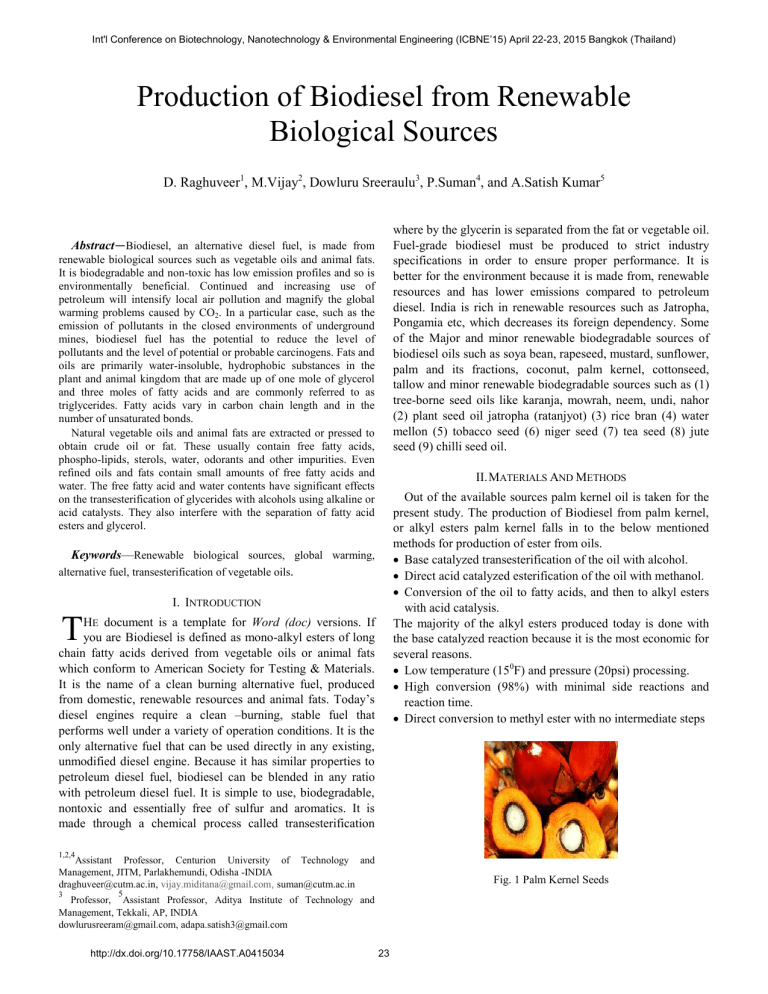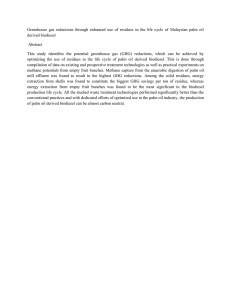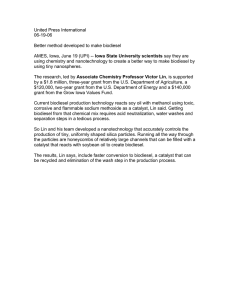Production of Biodiesel from Renewable Biological Sources

Int'l Conference on Biotechnology, Nanotechnology & Environmental Engineering (ICBNE’15) April 22-23, 2015 Bangkok (Thailand)
Production of Biodiesel from Renewable
Biological Sources
D. Raghuveer
1
, M.Vijay
2
, Dowluru Sreeraulu
3
, P.Suman
4
, and A.Satish Kumar
5
Abstract — Biodiesel, an alternative diesel fuel, is made from renewable biological sources such as vegetable oils and animal fats.
It is biodegradable and non-toxic has low emission profiles and so is environmentally beneficial. Continued and increasing use of petroleum will intensify local air pollution and magnify the global warming problems caused by CO
2
. In a particular case, such as the emission of pollutants in the closed environments of underground mines, biodiesel fuel has the potential to reduce the level of pollutants and the level of potential or probable carcinogens. Fats and oils are primarily water-insoluble, hydrophobic substances in the plant and animal kingdom that are made up of one mole of glycerol and three moles of fatty acids and are commonly referred to as triglycerides. Fatty acids vary in carbon chain length and in the number of unsaturated bonds.
Natural vegetable oils and animal fats are extracted or pressed to obtain crude oil or fat. These usually contain free fatty acids, phospho-lipids, sterols, water, odorants and other impurities. Even refined oils and fats contain small amounts of free fatty acids and water. The free fatty acid and water contents have significant effects on the transesterification of glycerides with alcohols using alkaline or acid catalysts. They also interfere with the separation of fatty acid esters and glycerol.
Keywords —
Renewable biological sources, global warming, alternative fuel, transesterification of vegetable oils
.
I.
I NTRODUCTION
T H E document is a template for Word (doc) versions. If you are Biodiesel is defined as mono-alkyl esters of long chain fatty acids derived from vegetable oils or animal fats which conform to American Society for Testing & Materials.
It is the name of a clean burning alternative fuel, produced from domestic, renewable resources and animal fats. Today’s diesel engines require a clean –burning, stable fuel that performs well under a variety of operation conditions. It is the only alternative fuel that can be used directly in any existing, unmodified diesel engine. Because it has similar properties to petroleum diesel fuel, biodiesel can be blended in any ratio with petroleum diesel fuel. It is simple to use, biodegradable, nontoxic and essentially free of sulfur and aromatics. It is made through a chemical process called transesterification
1,2,4
Assistant Professor, Centurion University of Technology and
Management, JITM, Parlakhemundi, Odisha -INDIA draghuveer@cutm.ac.in, vijay.miditana@gmail.com
, suman@cutm.ac.in
3
Professor,
5
Assistant Professor, Aditya Institute of Technology and
Management, Tekkali, AP, INDIA dowlurusreeram@gmail.com, adapa.satish3@gmail.com where by the glycerin is separated from the fat or vegetable oil.
Fuel-grade biodiesel must be produced to strict industry specifications in order to ensure proper performance. It is better for the environment because it is made from, renewable resources and has lower emissions compared to petroleum diesel. India is rich in renewable resources such as Jatropha,
Pongamia etc, which decreases its foreign dependency. Some of the Major and minor renewable biodegradable sources of biodiesel oils such as soya bean, rapeseed, mustard, sunflower, palm and its fractions, coconut, palm kernel, cottonseed, tallow and minor renewable biodegradable sources such as (1) tree-borne seed oils like karanja, mowrah, neem, undi, nahor
(2) plant seed oil jatropha (ratanjyot) (3) rice bran (4) water mellon (5) tobacco seed (6) niger seed (7) tea seed (8) jute seed (9) chilli seed oil.
II.
M ATERIALS A ND M ETHODS
Out of the available sources palm kernel oil is taken for the present study. The production of Biodiesel from palm kernel, or alkyl esters palm kernel falls in to the below mentioned methods for production of ester from oils.
Base catalyzed transesterification of the oil with alcohol.
Direct acid catalyzed esterification of the oil with methanol.
Conversion of the oil to fatty acids, and then to alkyl esters with acid catalysis.
The majority of the alkyl esters produced today is done with the base catalyzed reaction because it is the most economic for several reasons.
Low temperature (15
0
F) and pressure (20psi) processing.
High conversion (98%) with minimal side reactions and reaction time.
Direct conversion to methyl ester with no intermediate steps
Fig. 1 Palm Kernel Seeds http://dx.doi.org/10.17758/IAAST.A0415034
23
Int'l Conference on Biotechnology, Nanotechnology & Environmental Engineering (ICBNE’15) April 22-23, 2015 Bangkok (Thailand)
The productivity and yield of Jatropha and Pongamia was compared with palm kernel in Table 1.
S.
No parameter
T ABLE 1
COMPARISON OF PALM KERNEL SEEDS WITH J ATROPHA A ND P ONGAMIA
Jatropha
Curcas
Pongamia
Pinnate
Palm
Kernel
Seeds
1
2
3
4
Planting density
Productivity
Life Span
Yield per hectare / year
1,000 plants per Acre
Starts yielding after
1 st
year
50 years
0.4 to 12 tonnes
200 to 250 plants per
Acre
Starts yielding after
3 rd
year
100 years
6 to 9 tonnes.
60 to 70 plants per
Acre
Starts yielding from 8 th year.
30 years
18.5 tonnes and 750 kg of seed kernels,
Each tree of Palm Kernel can yield 40 Liters of oil, 120 Kg of fertilizer grade oil cake and 250 Kg of biomass as green manure per year. The expected oil content on whole FFB basis is 25 per cent, oil content in Mesocarp of fruits is 40 per cent, and oil content in kernel (seed) is 10 per cent.
Sources of Vegetable Oils: Palm Kernel oil was obtained and parameters like density, acid value, molecular weights and free fatty acid compositions are determined. The palm kernel seeds can be shown in fig. 1 and the Densities, Acid values and
Molecular weights of palm kernel oil are shown in Table-2.
T ABLE II
D ENSITIES , A CID VALUES AND M OLECULAR WEIGHTS OF PALM KERNEL OIL
Acid Mol.
Name of the Oil Density
Value Weight
1:9 to 1:18 and the effect of catalyst concentrations in the range of 0.5 to 1.0 wt%. The physical properties of the biodiesel samples obtained from experimental analysis have been evaluated for comparison [1].
A.
Experimental Setup
The experimental setup was shown in fig. 2 & 3. Three necked flat bottomed glass flask of 500ml capacity was used for transesterification reaction. A double coiled reflux condenser was fitted to a neck of the glass flask for condensing methanol vapors during the reaction. Ice cooled water was circulated through coils of the condenser. A thermo-well was fitted to the second neck of the flask. Thermo-well was filled with a thermometric liquid (Ethylene Glycol). A glass thermometer of 0-100
0
C range was placed in the thermo-well to measure the temperature of the reaction mixture. A plate heater with a magnetic stirrer was used for uniform heating of the contents of the flask. Oil, methanol and other chemicals were transferred through the third neck of the flask at the start of each experimental run using glass funnel and was stoppered during the reaction. A constant temperature bath was provided to maintain the temperature of the contents in the flask in the range 60-63
0
C.
Description of the experimental setup:
Apparatus: The important apparatus are Hot plate with magnetic stirrer (220/230 V 50
1
AC Amperes 1.8),
Magnetic element, Three necked flat bottom flask with neck size of 24/29 and 500 ml (made of Borosil glass), Reflux coil condenser (Joint size 24/29), Thermo-well filled with thermometric liquid (Ethylene Glycol), Thermometer of 0-
100 o
C range. Transesterification setup as shown in fig. 2 of
500 ml (made of Borosil glass) and separating funnels as shown in fig. 3 below
Palm Kernal oil
Jatropha biodiesel
Pongamia Pinnate oil
0.902
0.88
0.88
4.2
3-38
1.0 to
38.2
886
870
886.61
III.
E XPERIMENTAL W ORK
In the present investigation, experimental work was carried out using different feed stocks of vegetable oils were undertaken. The process development studies are divided into three steps.
Preconditioning of oil.
Effect of catalyst concentration and mole ratio of oil to alcohol in transesterification reaction.
Purification of products and recovery of methanol.
The physical properties such as Kinematic Viscosity, Fire
Point, Carbon Residue, p
H
, Flash Point, Acid Value are evaluated for the biodiesel samples obtained in the process development work.
The transesterification of the Palm Kernel oil has been carried out using sodium hydroxide as catalyst. These studies include the effect of mole ratio (oil to alcohol) in the range of
Fig. 2 Experimental Setup
Fig. 3 Separating funnel http://dx.doi.org/10.17758/IAAST.A0415034
24
Int'l Conference on Biotechnology, Nanotechnology & Environmental Engineering (ICBNE’15) April 22-23, 2015 Bangkok (Thailand)
B.
Experimental Procedure
Preconditioning of oil: Preconditioning of oil involved the removal of the moisture and neutralization of Free Fatty Acids
(FFA).Usually refined oils consist less than 5% of FFA but they need to be neutralized as they result in the formation of soap.For determination of FFA present in the oil taken, we titrated the oil sample with 0.1N KOH solution with
Phenolphthalein as indicator. Volume in ml of 0.1N KOH required to neutralize one gram of oil is called acid value. And with this we determined the amount of KOH needed to neutralize the FFAs in the oil. Thus by adding calculated amount of KOH, FFAs are removed in the form of soap.
Removal of moisture involved heating the oil sample upto105-
110
0
C and maintaining it there for few minutes so that all moisture gets evaporated if required vacuum pump arrangement is used to remove the moisture present [2].
Transesterification Reaction: The most common derivatives of agricultural oil for fuels are methyl esters. These are formed by transesterification of the oil with methanol in the presence of a catalyst (usually basic) to give methyl ester and glycerol.
Sodium hydroxide (NaOH) is the most common catalyst, though others such as potassium hydroxide (KOH) can also be used and is shown in fig. 4.
Fig. 4 100 kg oil+24 kg methanol+2.5 kg NaOH a 100 kg biodiesel+26 kg glycerine
Calculated amount of oil sample is taken in thee necked flat bottom flask and it is put over the flat plate heater and heated to this methanol taken in 9:1 mole ratio (alcohol to oil) is gently added such that no amount of methanol gets evaporated. The condenser is readily fitted to one of the neck of the three necked flask. To the other neck, thermometric well is fixed and the third neck is closed with a stopper. Now the stirrer is put on, and the whole batch of oil and methanol are thoroughly mixed to attain uniform reaction. The temperature of the bath is maintained in the range of 60-63
0
C and the reaction is carried out for one hour. After the reaction time is over, the batch is withdrawn from the heater and cooled to room temperature on cooling formation of two layers are observed. This whole batch is poured into a separating funnel and allowed for at least 5 hour. To get clear separation of ester and glycerine. Glycerine formed at the bottom is taken out as a by-product. The obtained ester is subjected to further purification. The Trans-Esterification process (Reaction) is shown in fig. 5.
Fig.5. Trans-Esterification process (Reaction)
The methanol and NaOH are premixed and added to the oil, mixed for a few hours, and allowed to gravity settle for about 8 hours. The glycerine settles to the bottom, leaving biodiesel on the top. The physical and chemical properties of the resulting biodiesel (Jatropha methyl esters) are presented in the following Table alongside those for petroleum diesel and
European Union standards for biodiesel [1].
Purification of products and recovery of methanol: For removing the catalyst present in the ester small amount of glacial acetic acid is added to get a neutral ester and then it is washed with hot distilled water to remove any traces of catalyst present. Washing is done with distilled water at 50
0
C,
65
0
C and 80
0
C to remove traces of methanol or catalyst. Thus ester obtained is dehydrated to remove traces of moisture present in it and it is heated to 60-110
0
C remove excess methanol present in it. Thus obtained ester is almost 100% pure. Yields of esters: The yields of methyl Palm Kernal ester at 0.5, 0.75 and 1.0 wt% of sodium hydroxide catalyst were taken
IV.
R ESULTS A ND D ISCUSSION
As observed from results, the yields of Palm Kernel ester, ranged from 90% to 99.6%. Irrespective of different mole ratios and catalyst concentrations, the yields were more or less same with about 3-9% variation. In case of methyl Palm
Kernel ester, at 1:9mole ratio and 0.5, 0.75 &1 wt% of catalyst
(NaOH) the % yield was 98.5%, 98% & 87.5% respectively. http://dx.doi.org/10.17758/IAAST.A0415034
25
Int'l Conference on Biotechnology, Nanotechnology & Environmental Engineering (ICBNE’15) April 22-23, 2015 Bangkok (Thailand)
A.
Effect of Mole Ratio on pH
The values of pH are in increasing trend when the mole ratio is increased from a value of 1:9 to 1:18 in Palm Kernel ester.
The variation of pH with mole ratios is shown in fig. 6.
Fig. 6 Mole ratio Vs pH at various catalyst concentrations for methyl palm kernal easter with NaOH catalyst
B.
Effect of Mole Ratio on kinematic viscosity
The values of kinematic viscosity are also in decreasing trend when the mole ratio is increased from a value of 1:9 to
1:18 in Palm Kernel ester. The variation of kinematic viscosities with mole ratios was shown in fig. 7.
Fig.8 Catalyst concentration Vs kinematic viscocity at various catalyst concentrations for methyl palm kernal oil with NaOH catalyst
D.
Effect of mole ration on flash point
The values of flash points gradually decreased for Palm
Kernel ester as the mole ratio was increased. This sudden decrease in the flash points may be because that the esters at greater mole ratios become very volatile and because of which it is producing sufficient vapors at its volatile temperature which is very low compared to the esters which were less volatile. The variation of flash points with change in mole ratios is shown in fig. 9
[3].
Fig.9 Mole ratio Vs Flash poiny at various catalyst concentrations for methyl palm kernal oil with NaOH catalyst
Fig.7 Mole ratio Vs kinematic viscocity at various catalyst concentrations for methyl palm kernal oil with NaOH catalyst
C.
Effect of catalyst concentration on kinematic viscosity
The effect of catalyst concentration on kinematic viscosity is shown in fig. 8. The values of kinematic viscosities decreased when the catalyst concentration is raised from 0.5% to 1.0%. It is clear from these results that the conversion of oil to ester is low even the concentration of the catalyst at 0.5%. At the 1.0% catalyst concentration, the values of kinematic viscosity of the ester are significantly reduced indicating the fact that the minimum catalyst concentration should be in the vicinity of
1.0%. Obviously higher values of density are recorded for the
Palm Kernel ester because of low conversion of oil to ester.
E.
Effect of mole ratio on fire point
The values of Fire Points are also in decreasing trend when the mole ratio is increased from a value of 1:9to 1:18 in Palm
Kernel ester. The variation of Fire Points with mole ratios is shown in fig. 10
[4].
http://dx.doi.org/10.17758/IAAST.A0415034
26
Int'l Conference on Biotechnology, Nanotechnology & Environmental Engineering (ICBNE’15) April 22-23, 2015 Bangkok (Thailand)
There are several advantages of biodiesel produced from Palm
Kernel oil. As biodiesel is more viscous, its lubricity is more.
Settling of two layers at separation stage is faster for Palm
Kernel oil, so separation is easy and faster. The biodiesel obtained from non-edible oils is cheaper than that from edible oils. Finally it can be concluded that the biodiesel is a better alternative fuel when compared to conventional diesel [7].
Waste/arid lands can be utilized for growing trees like jatropha, mahua, castor etc. There will be substantial employment generation mainly in the rural areas which will help in the overall development of these areas. [8]
Fig.10 Mole ratio Vs Fire poiny at various catalyst concentrations for methyl palm kernal oil with NaOH catalyst
F.
Performance of Biodiesel
Successful alternative fuels fulfill environmental and energy security needs without sacrificing operating performance.
Operationally, biodiesel performs very similar to low sulfur diesel in terms of power, torque, and fuel without major modifications of engines or infrastructure. Biodiesel offers similar power to diesel fuel. Biodiesel has a higher cetane number than diesel fuel. In over 15 million Miles of in-field demonstrations biodiesel showed similar fuel consumption, horsepower, torque, and haulage rates as conventional diesel fuel. Biodiesel provides significant lubricity improvement over petroleum diesel fuel. Lubricity results of biodiesel and petroleum diesel using industry test methods indicate that there is a marked improvement in lubricity when added to conventional diesel fuel [5,6].
Biodiesel contains no sulfur or aromatics, and use of biodiesel in a conventional diesel engine results in substantial reduction so unburned hydrocarbons, carbon monoxide and particulate matter. Biodiesel can be manufactured using existing industrial production capacity and used with conventional equipment, is provides substantial opportunity for immediately addressing our energy security issues.
Increased utilization of renewable biofuels results in significant microeconomic benefits to both the urban and rural sectors.
V.
C ONCLUSIONS
Biodiesel is safe to handle because it is biodegradable and non-toxic. Biodiesel reduces all the emission. Biodiesel can be used alone or mixed in any amount with petroleum diesel fuel.
Biodiesel runs in any conventional, unmodified diesel engine.
No engine modifications are necessary to use biodiesel and there is no ―engine conversion‖. Increased utilization of renewable biofuels results in significant microeconomic benefits to both the urban and rural sectors, and the balance of trade. It is clear that more can be done to utilize domestic surpluses of vegetable oils while enhancing our energy security. Because biodiesel can be manufactured using existing industrial production capacity, and used with conventional equipment, it provides substantial opportunity for immediately addressing our energy security issues.
R EFERENCES
[1] Peterson, Charles L., Feldman, M., Korus, R., and auld, D.L ., ―Batch type transesterification process for winter rape oil‖, ASAE paper ,
St.Joseph, 1991, MI 49085- 9659.
[2] Nicaragua Bringi, N.V., "Non-Traditional Oilseeds and Oils in India", the Biomass Project, Curcas Oil Methyl Ester, Oxford & IBH
Publishing Co. Pvt. Ltd. New Delhi, India, 2000, pp 143-166.
[3] Cole, G. Mattney, ―Assessment and remediation of petroleum contaminated sites and test guidelines, aerobic aquatic bio degradation‖, publishers 1982 test guidelines chemical fate-aerobic aquatic bio degradation, 2003
[4] Shaine Tyson nrel golden, U.S.Department of energy, Colorado, USA,
Biorefinery. 2003.
[5] Das, ―Performance evaluation and emission characteristics of a compression ignition engine using esterified Biodiesels‖ CES, IIT Delhi,
1996.
[6] LM Das, ―Biodiesel development and characterization for use as a fuel in compression ignition engine‖, Journal of engineering for gas turbine and power (ASME Transaction journal), vol.123, 2001, pp440-447.
[7] Pitter, Pavel and Chudoba ―biodegradability of organic substances in the aquatic environment‖, CRC press , 1990, pp167.
[8] Jeffrey L. Rosenblum, ―Feasibility of Biodiesel for Rural Electrification in India‖, Carnegie Mellon University http://dx.doi.org/10.17758/IAAST.A0415034
27




